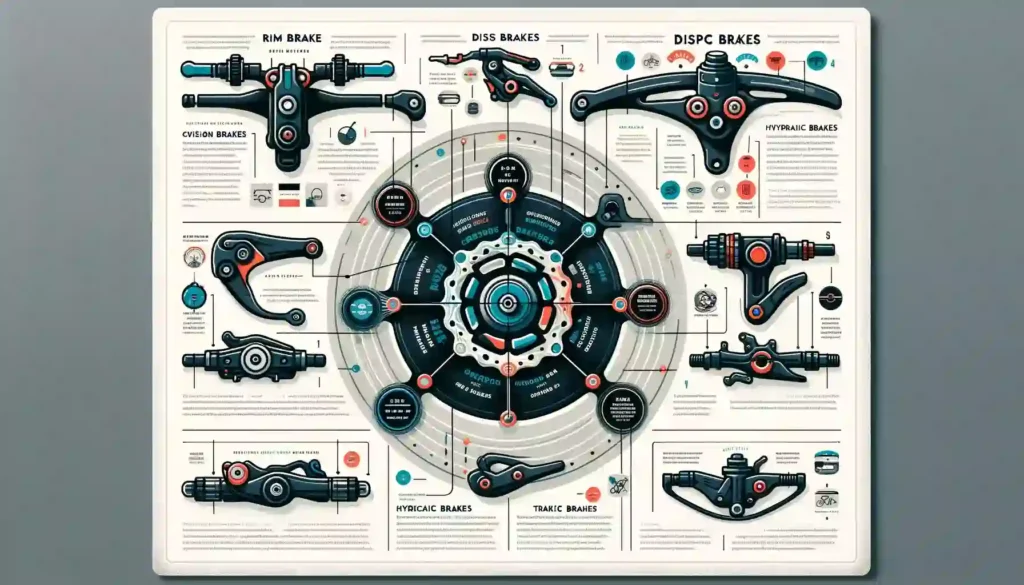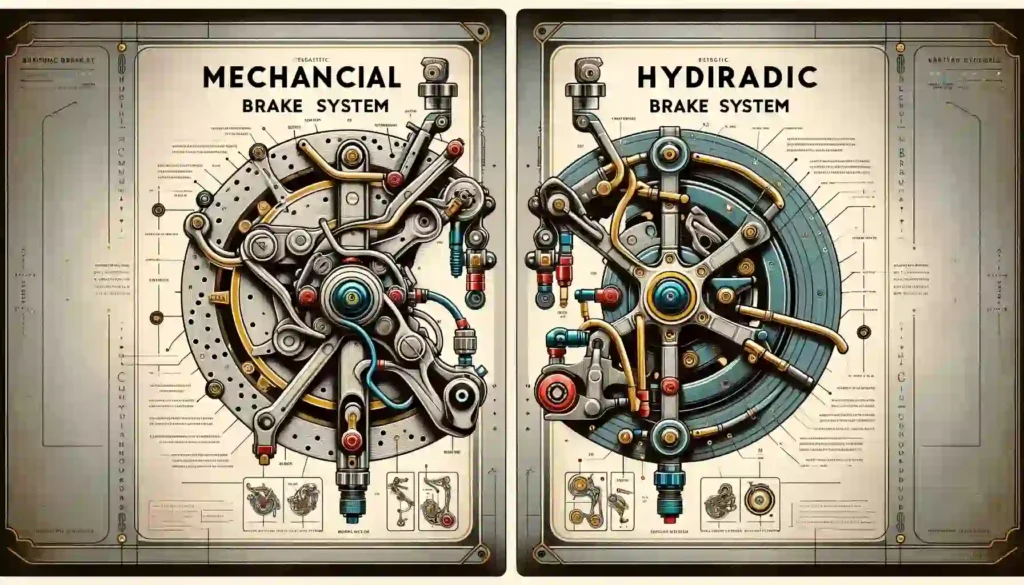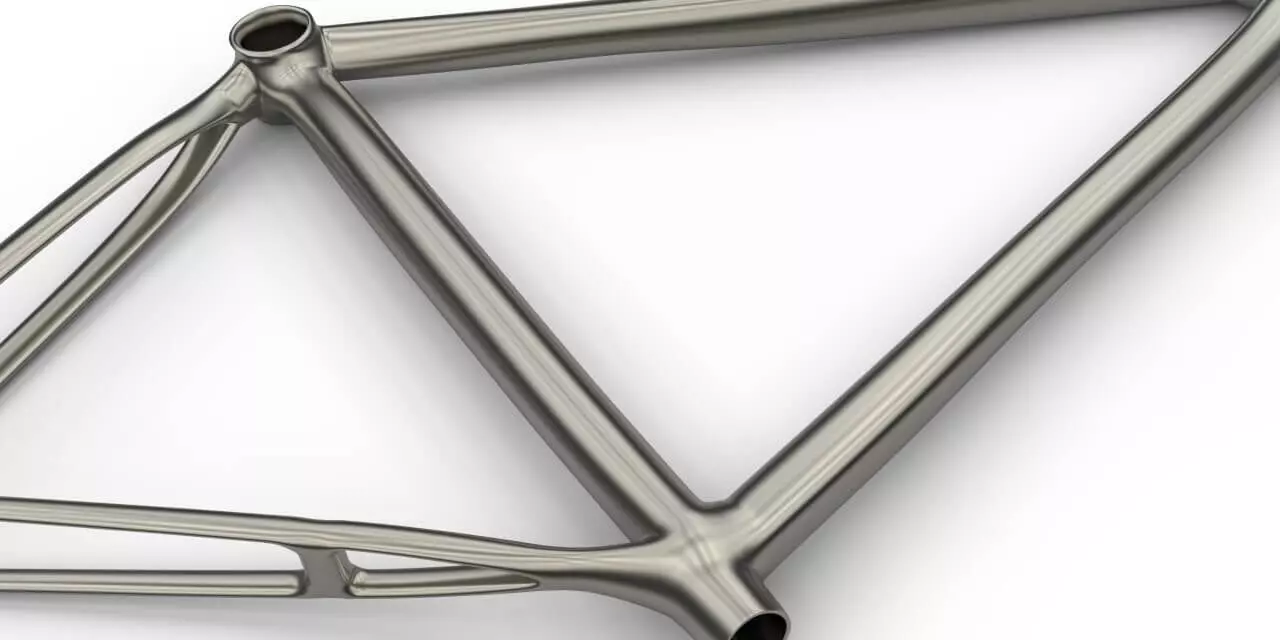Under road traffic regulations, bicycles must be equipped with effective brakes. However, there are various types of bicycle brakes available in the market, each with its advantages and disadvantages. Our article helps you navigate the complex world of bicycle brakes, providing you with quick and essential information.
What Types of Bicycle Brakes Exist?
A reliable bicycle brake is a crucial component of any bicycle, ensuring safety on the roads. However, not all bicycle brakes are created equal. They vary in several aspects. Most bicycles are fitted with rim brakes, but modern bikes often feature disc brakes.
Additionally, bicycle brakes differ in their functionality, being either mechanical or hydraulic, both playing a vital role in halting your bike when you engage the brake lever. To provide an overview, we’ve compiled information on the most common types of bicycle brakes, exploring their mechanisms as well as their strengths and weaknesses.

Difference Between Mechanical and Hydraulic Brake Types
Mechanical and hydraulic bicycle brakes fundamentally differ in how brake force is transmitted from the lever to the brake itself.
In a mechanical brake system, the force is transferred via a cable, also known as a Bowden cable, connecting the handlebar lever to the brake pads on the wheel. This cable comprises a thin steel wire encased in a pressure-resistant outer shell. Pulling the lever in a mechanical brake system tightens this cable, applying force to the wheel’s brake system. Common mechanical brakes include rim brakes and drum brakes.
Conversely, hydraulic bicycle brakes consist of a closed system filled with brake fluid and hydraulic oil. When the rider operates the brake lever, the force is transmitted through a brake cylinder to the brake pads. The pads then exert pressure on the rim or brake disc, creating the braking force. The basis of hydraulic brakes lies in the principle that liquids are nearly incompressible, allowing the brake pressure to be directly transmitted.
Hydraulic Brake or Mechanical Bicycle Brake?
Determining which type of bicycle brake is superior is not straightforward. Rim brakes and disc brakes based on hydraulics offer more braking power with less hand force, allowing for more precise modulation. On the downside, hydraulic bicycle brakes are more complex to install and adjust, require more maintenance time, and are costlier than mechanical brakes. However, hydraulic brakes offer almost maintenance-free usage compared to mechanical ones.
Now that you know how hydraulic and mechanical brakes work and their differences, let’s take a closer look at the various types of bicycle brakes.

Overview of Brake Types in Bicycles
The most common types of brakes found on bicycles today are rim and disc brakes, available in both mechanical and hydraulic designs. However, the mechanical disc brake type is becoming increasingly rare.
1. Rim Brake
Rim brakes are among the most popular types of bicycle brakes. They are considered standard for city bikes, road bikes, and trekking bikes. This brake consists of two pads that press against the rim from each side, reducing speed. Variants of rim brakes include V-Brakes, cantilever brakes, U-brakes, and side-pull brakes. While primarily mechanical, hydraulic rim brakes are also available.
2. V-Brake (V-Brakes)
V-Brakes are commonly found on bicycles. They feature longer brake arms for more effective and easier braking than cantilever brakes. V-Brakes do not have a transverse cable connecting the two brake arms but have a canti-socket for mounting the brake pads. Older bicycles often upgrade to V-shaped brakes during repairs. Developed by Shimano, V-Brakes are also known as Shimano V-Brakes. Other manufacturers offer this type of brake as Linear Pull Brake or Direct Pull Brake.
3. Cantilever Brake
The term ‘cantilever brake’ derives from the English word ‘cantilever’, meaning lever arm. This brake type operates through two tilting levers located on the cantilever socket. The brake arms are connected by a transverse cable. This design became popular with the rise of mountain biking but was largely replaced by V-Brakes from the 1990s onward. Today, they are less common and primarily found on cyclocross bikes or children’s bicycles.
4. U-Brake (U-Brakes)
U-Brakes are characterized by robust brake arms that cross above the wheel. The right transverse cable moves the left brake arm and vice versa. The mounting is above the rim, making U-Brakes not easily interchangeable with V-Brakes. Initially used on mountain bikes before cantilever brakes, they are now primarily used on freestyle BMX bikes.
5. Side-Pull Brake
Unlike the V-Brake, the brake cable in a side-pull brake runs along only one side. Side-pull brakes are more common on racing bikes where the fork is too
thin to mount a canti-socket. Also known as caliper brakes, the asymmetrically mounted brake arms extend around the wheel, forming the brake caliper. For effective braking, the wheels need to be thin, as thicker tires reduce braking power due to longer brake arms.
6. Hydraulic Rim Brake
Hydraulic rim brakes are mounted on bicycle struts. Two opposing brake shoes press against the rim flanks. Typically, the brake cylinders are mounted on a plate connected to the cantilever socket. Alternatively, they can be directly attached to the struts without an additional mounting plate. Despite their effective braking performance, mainly the manufacturer Magura produces hydraulic rim brakes.
7. Disc Brake
Disc brakes work similarly to car brakes, with brake discs mounted on the hubs of the front and rear wheels. When the rider brakes, the force is not transmitted to the rim but to the mounted brake disc. The disc is equipped with a piston that slows down the bike.
To mount disc brakes on the fork, it must have a facility to attach the brake disc. Therefore, switching from rim brakes to disc brakes can be challenging. For the rear wheel, this would only be possible with a complete frame swap.
The performance of disc brakes can be pre-scaled, meaning larger brake discs achieve a higher effect when braking. This is particularly advantageous for bikes used in sports.
Also read: Bicycle Tires Explained: Types, Structure, and Choosing the Right One.
Advantages and Disadvantages of Rim and Disc Brakes
Rim brakes and disc brakes, while both effective in braking, have their strengths and weaknesses. We’ve compared both variants of bicycle brakes and compiled their advantages and disadvantages. For example, an advantage of disc brakes becomes a disadvantage for rim brakes, and vice versa.
An illustrative example is braking performance in wet conditions. Disc brakes have an advantage here, which simultaneously presents a problem for rim brakes.
Advantages of Disc Brakes
- No wear on the rims
- Better braking performance in wet conditions
- Equal braking power with up to 20% less hand force
- Longer-lasting brake pads for disc brakes
- Rims do not grind against the brake discs
- Better suited for very thick tires
- No overheating of the rims on long descents
Advantages of Rim Brakes
- Lighter than disc brakes
- Hydraulically cheaper compared to hydraulic disc brakes
- Technically easy to maintain (adjustment and repair)
- Less stress on hubs and spokes
- Robust construction better protects against shocks
- Rim brakes do not need to be broken in
- No overheating of the brake discs on long downhill rides
Disc brakes, especially compared to older rim brakes, have significant advantages. Overall, the trend is moving away from rim brakes towards disc brakes. Interest in disc brakes is particularly high for new bicycles. Only budget models still rely on rim brakes.
Coaster Brake
Coaster brakes are located at the rear wheel hub of the bicycle. The rider activates them by moving the pedals backward, i.e., pressing the foot against the normal rotation. This action abruptly stops the rear wheel.
The coaster brake operates through a connection from the crank via the bicycle chain and is therefore available only with hub gears or single-speed bicycles. They are still used on various types of bicycles: city bikes, children’s bikes, and as an additional brake on e-bikes.
The advantage of a coaster brake is its robustness and low maintenance. It also works in all weather conditions. The disadvantage is that if the chain comes off, the brake cannot be operated. Moreover, the braking force is difficult to modulate.
Roller Brake
Roller brakes are a special type of coaster brake based on the roller principle. The braking force is generated by metal rollers pressing against a brake shell. The rider can operate the roller brake on the front or rear wheel via the brake lever on the handlebar.
This type of brake was developed to make the braking process smoother and prevent abrupt stopping. Shimano is currently the only manufacturer of roller brakes. They are often installed on bicycles requiring low braking power.
Read the details: Roller Brakes: Capabilities and Ideal Users.
Drum Brake
A drum brake on a bicycle works similarly to a roller brake. However, instead of rollers, two brake blocks inside a drum are used. The brake pads press against the drum’s inner wall, creating the braking effect. This type of bicycle brake is rare, as few manufacturers like Sturmey-Archer produce these brakes.
Rod Brake, Block Brake, and Spoon Brake
One of the oldest types of bicycle brakes is the rod brake. Until the 1980s, this type of brake was widespread in East Germany. It is also known as a block brake or spoon brake. A rubber block is pressed against the front tire during braking.
However, this creates high pressure, increasingly affecting the tire tread. Due to high wear and poor braking performance, especially in wet conditions, rod brakes are now a rarity.
Brands and Manufacturers of Bicycle Brakes
Shimano is undoubtedly the most well-known brand for bicycle brakes. As a market leader, the manufacturer caters to all target groups and offers suitable products. The Japanese company continually develops innovative bicycle components, setting itself apart from competitors.
Other significant manufacturers include SRAM and Campagnolo. Also noteworthy is the young Chinese company Tektro, which offers reliable and affordable bicycle brakes. Magura is a notable brand for hydraulic brakes, produced by the German company Magenwirth Technologies.
Choosing the Right Bicycle Brake: Which Type is Best?
When considering which bicycle brake is the best fit for you and your bike, the primary question revolves around your intended use. Your choice should be based on the purpose of your bicycle. Hydraulic disc brakes offer the best braking performance, crucial for racing bikes and mountain bikes where strong braking power is vital.
They are also suitable for heavy e-bikes. On the other hand, mechanical brake types usually require significant hand force to stop the bicycle effectively.
For bikes used in urban traffic, a disc brake might not be necessary. A rim brake, with its lighter weight and lower cost, may suffice. If you plan to change the brakes on your bike, ensure that the new brakes are compatible with your frame or fork. Disc brakes require a different setup than cantilever brakes, V-Brakes, or U-Brakes.








